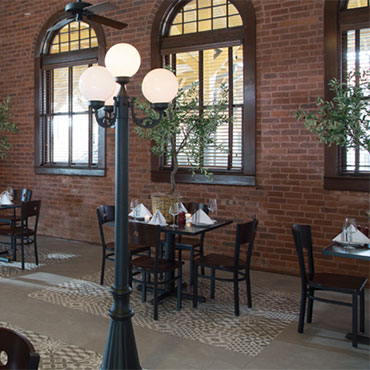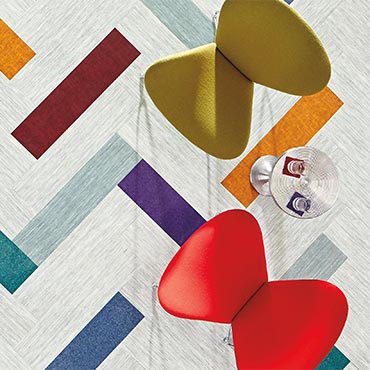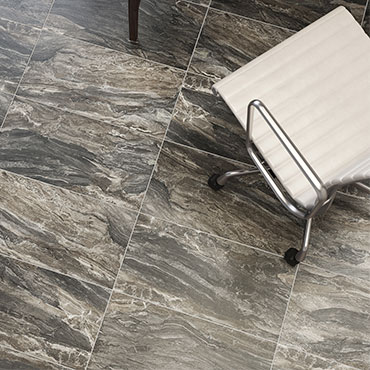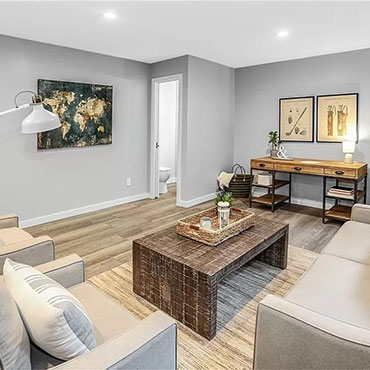Adura is the next generation of luxury vinyl, and the fastest growing category in the flooring business. Why? Adura provides the look and elegance of wood, tile, or stone without the worry! Available in a variety of shapes, sizes, textures, and installation options, Adura delivers award-winning fashion to your home. With proprietary technology, Adura is engineered to look and feel like the real thing, easy to maintain, and is backed up by a limited lifetime residential/6 year light commercial warranty. Learn More
Luxury Vinyl Flooring
Luxury Vinyl Flooring Guide

Revolutionizing Modern Spaces: The Rise of Luxury Vinyl Flooring in Design
In the realm of architectural and interior design, the evolution of flooring materials has been a quiet yet transformative journey. Among these advancements, Luxury Vinyl Flooring (LVF) stands out as a modern, versatile choice, increasingly favored in both residential and commercial spaces. Its growth in popularity reflects a blend of durability, aesthetic appeal, and practicality, making it a compelling choice for architects, interior designers, and building specifiers.
Material Composition and Durability: A Robust Foundation
Luxury Vinyl Flooring comprises several layers, each contributing to its overall resilience and appeal. The wear layer, sitting at the top, offers protection against daily wear and tear, making it ideal for high-traffic areas. Beneath this is the print layer, where diverse designs and patterns come to life. The core layer adds structural stability, while the backing layer ensures a firm grip to the subfloor.
This composition makes LVF exceptionally resistant to scratches, dents, and moisture. The advanced technology behind these layers ensures that the flooring withstands the rigors of heavy use while maintaining its aesthetic value.
Design Flexibility and Aesthetic Appeal: The Creative Edge
LVF offers an impressive range of textures, patterns, and colors, making it a designer’s delight. Its ability to mimic natural materials like wood and stone is particularly noteworthy. This versatility allows architects and designers to integrate LVF into various design themes, from classic to contemporary, without compromising on style or quality.
Environmental Considerations and Sustainability: A Conscious Choice
In the era of environmental consciousness, the impact of flooring materials cannot be overlooked. The production and disposal of LVF have been subjects of scrutiny. However, strides in using recycled materials and eco-friendly manufacturing processes have positioned LVF as a more sustainable option. Certifications from recognized environmental bodies further attest to its eco-friendly attributes.
Installation and Maintenance: Simplifying Processes
One of the standout features of LVF is its ease of installation. Unlike traditional flooring options, LVF can be installed quickly and with minimal disruption, a significant advantage in fast-paced construction environments. Maintenance is equally straightforward, requiring basic cleaning and occasional care, setting it apart from more high-maintenance flooring materials.
Cost-Effectiveness and Market Trends: Balancing Quality and Budget
In terms of cost-effectiveness, LVF strikes an impressive balance between initial investment and long-term value. Its durability and low maintenance requirements make it a cost-efficient choice over its lifecycle. Current market trends indicate a growing preference for LVF, particularly in sectors where both aesthetics and budget are key considerations. This trend is expected to continue, with LVF carving a significant niche in the luxury flooring market.
Real-world Applications: Proving Its Mettle
The practical application of LVF in notable projects underscores its capabilities. Be it in bustling retail spaces, high-end residential complexes, or dynamic office environments, LVF has demonstrated its ability to meet diverse design and functional demands. These case studies provide valuable insights into its adaptability and performance in real-world settings.
Conclusion: Embracing the Future of Flooring
For architects, interior designers, and building specifiers, Luxury Vinyl Flooring offers a blend of durability, design versatility, and practicality. Its evolution reflects a deep understanding of modern design needs and challenges. As the industry continues to innovate, LVF stands as a testament to how modern materials can redefine spaces, balancing aesthetic desires with practical realities. Embracing LVF in future projects isn’t just about choosing a flooring material; it’s about adopting innovative solutions that meet the evolving demands of contemporary design.
Disclaimer: The information provided in this article is for general informational purposes only. While we strive to ensure the accuracy and reliability of the information presented, we make no warranties, express or implied, about the completeness, accuracy, reliability, suitability, or availability with respect to the content. Any reliance you place on such information is strictly at your own risk. We recommend consulting with professionals for specific advice tailored to your project’s needs, particularly regarding building codes, regulations, and product specifications.
Under no circumstances shall we be liable for any loss or damage, including without limitation, indirect or consequential loss or damage, arising from the use of, or reliance on, the information provided in this article.
Luxury Vinyl Flooring
Top 4 Types of Luxury Vinyl Flooring
 LVT/LVP - 163 Luxury Vinyl Tile (LVT)Discover Luxury Vinyl Tile (LVT) for a blend of style and durability. Perfect for any room, LVT offers high-end aesthetics with easy maintenance and resilience. | |
 LVT/LVP - 479 Luxury Vinyl Plank Flooring (LVP)Discover the beauty and durability of Luxury Vinyl Plank Flooring (LVP). Ideal for any room, LVP offers a stylish look with easy maintenance and long-lasting performance. | Sub Categories: |
 LVT/LVP - 480 Luxury Vinyl Sheet FlooringUpgrade your space with Luxury Vinyl Sheet Flooring. Combining elegance and durability, it offers a seamless look with easy installation and long-lasting performance. | |
 LVT/LVP - 1164 Rigid Core Luxury Vinyl FlooringExplore Rigid Core Luxury Vinyl Flooring for unmatched durability and style. Ideal for high-traffic areas, it combines resilience with elegant design. | Sub Categories: |
Featured Brands
The Best 10 Luxury Vinyl Flooring Brands

Mannington Adura® Flooring
Profile | Website | Warranty | Install | MaintainAdura is the next generation of luxury vinyl, and the fastest growing category in the flooring business. Why? Adura provides the look and elegance of wood, tile, or stone without the worry! Available in a variety of shapes, sizes, textures, and installation options, Adura delivers award-winning fashion to your home. With proprietary technology, Adura is engineered to look and feel like the real thing, easy to maintain, and is backed up by a limited lifetime residential/6 year light commercial warranty. Learn More

Karndean Luxury Vinyl Flooring
Profile | Website | Design Tools | Tips | Maintain | FAQs | BlogKarndean has a heritage of hand selecting the raw materials that inspire our products. Designflooring provides you with realistic wood and stone effects but with none of the practical drawbacks of the materials that inspired them. Learn More

Congoleum Luxury Vinyl Flooring
Profile | WebsiteCongoleum has been, and still is, the resilient flooring expert since 1886. Over the decades Congoleum has honed and perfected our expertise surrounding resilient flooring. Learn More

Nova Luxury Vinyl Flooring
Profile | Website | Design Tools | Install | GreenNovalis matches concrete looks and wood-style plank accents to classic ornamental patterns to create an exciting contemporary statement. Abberly™ is designed and engineered for the demands of Main Street restaurants and retail settings with easy maintenance and lasting good looks. Learn More

Tarkett Luxury Vinyl Flooring
Profile | Website | Design Tools | Warranty | Install | Maintain | GreenLuxury vinyl planks and tiles offer complete design freedom with endless layout possibilities across a broad range of patterns, colorways, quality levels and installation formats. LVT withstands heavy traffic and is easy to maintain with extra resistance to scuffs, scratches and stains. For any segment, for any space, luxury planks and tiles is an optimized, inspired solution. Learn More

Southwind® Luxury Vinyl
Profile | Website | Design Tools | Warranty | Install | MaintainSouthwind only uses 100% virgin vinyl in their Luxury Vinyl products for superior durability and stability. Available in two installation methods, glue down or loose lay, there’s something to offer for every application. Learn More

AmericanBiltrite UltraCeramic
Profile | WebsiteUltraCeramic is a floor covering engineered to provide a better alternative to ceramic or stone. More durable and crack resistant than ceramic or stone and more forgiving when everyday articles fall on the floor. Learn More

MSI Luxury Vinyl Flooring
Profile | Website | Install | MaintainFinely Luxury Vinyl Tile from the Everlife Rigid Core (RC) Collection offers a palette of subtle grey tones and greiges that lend elegance to your space. This beautiful 7x48 wood-look luxury vinyl plank is 100% waterproof flooring, scratch, stain, and dent resistant, and backed by a lifetime residential warranty. Its innovative pre-attached backing ensures supreme comfort under foot while its easy-install locking system make this grey vinyl tile DIY-friendly. In the kitchen, living area, bathroom, basement, and beyond, there’s no easier way to create luxurious, affordable, low maintenance floors than with LVP Flooring. Find coordinating gray vinyl plank flooring trim pieces below. Available trim items include end caps, stair noses, reducers, and T-molding. Learn More

Milliken Commercial LVT
Profile | Website | Warranty | Install | Maintain | GreenMilliken Commercial LVT Flooring offers sustainable, high-performance solutions for architects, interior designers, and facility managers. With PVC-free collections and innovative designs, it enhances both functionality and aesthetic appeal. Learn More

Phenix LVT/LVP
Profile | WebsiteAs a leading manufacturer of luxury vinyl flooring, Phenix has been committed to producing the highest quality products since 2006. Using today’s most innovative technology, we make PetProtect® Luxury Vinyl and Rigid Core Luxury Plank that exceed industry standards. Learn More
Luxury Vinyl Flooring Videos
The Top 10 Luxury Vinyl Flooring Videos
Prime Waterproof Flooring - Luxury Vinyl Plank
Twelve Oaks - Surwood and SolidCore Vinyl Flooring
How to Install Luxury Vinyl Plank Flooring
Paradigm Waterproof Flooring - What is it? How it's made? Care/Maintenance
Hallmark Floors Videos
Forbo Flooring Systems Allura - LVT How It's Made
Install Quick-Step vinyl flooring on your walls
Amtico at Clerkenwell Design Week 2018
Official FreeFit Flooring: How to install FreeFit loose lay vinyl plank floors
Premium Click Vinyl : heat resistant & water proof flooring
Looking For A Waterproof Scratch Resistant Wood Floor? Introducing RevWood Plus
Installing COREtec Plus using Angle/Tap Profile
We Are Moduleo
Maya's Story
Luxury Vinyl Flooring: Upscale Luxury at Affordable Prices
How to Install ADURA®Max Vinyl Plank Floors
Alterna Installation Comparison
Luxury Vinyl Flooring News
Latest Luxury Vinyl Flooring News
What's the difference between linoleum and vinyl flooring?... installed pretty much anywhere. But there are some important differences between the two. Vinyl and vintage linoleum have a very different construction. All types of vinyl flooring — luxury vinyl flooring (or LVT), rigid core hybrid flooring, vinyl sheet and vinyl tile — are manufactured in layers. The top wear layer is a finish (such as urethane) that protects flo... |
Wood-Look Vinyl Flooring...lanks with our FasTak installation use a repositionable, pressure-sensitive adhesive, and most other vinyl flooring can be floated with boards that lock to each other and require no adhesive. Luxury vinyl flooring like our Luxe Plank® with Rigid Core Technology are also well suited to be used over subfloors that have minor irregularities. What kinds of wood styles are available in... |









